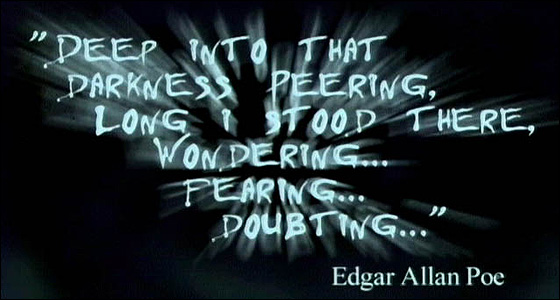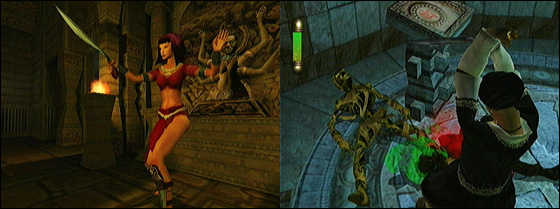Evaluating Eternal Darkness
November 22nd, 2009

If we consider games to consist of two key parts: The mechanical and the contextual, then mechanically-speaking Eternal Darkness isn’t a particularly interesting game. The foundation is simply the framework of a traditional, point and click adventure game, in 3D, and with a few combat elements layered on. The inherent nature of the genre (fetch questing and rubbing items against random pieces of the environment) relies on the solid construction of puzzles and contextual bits in between to make itself enjoyable. I mean, running around and randomly clicking on everything isn’t particularly fun now, is it? If we’re to evaluate Eternal Darkness then it’s fundamental that we judge it on these two points, the contextual and the construction of puzzles and other mechanics.
The Contextual Bits
The literary story of Eternal Darkness is clearly the game’s greatest strength. It spooks me and not because of its psychological undertones. The narrative, a well integrated mix of cutscenes, text and in-game elements, doesn’t feel like anything from a video game. It’s a complicated tale dealing with complicated themes and it treats itself very seriously. Eternal Darkness‘ narrative spooks me because it gives me a story which I care about and a cast of characters that I can sympathize with—and as a fan of this power-fantasy-heavy medium I can’t help but be taken back by the maturity and adherence to quality.
The music and camera work are also standout qualities which drive the atmosphere immensely. The music feels weighty, knowing when to quiet down and let the ambiance take over. The camera is surprisingly dynamic, sliding around the environment, always looking for angles in which to frame the player in a vulnerable position. In this regard the camera itself is rather frightening as its prosecutes the player’s subordination. The camera is probably the single biggest factor contributing to the superb and much touted sanity effects. As the player traverses the environment their intersections with the undead causes their sanity meter to decrease, resulting in a series of bizarre gameplay- and presentation-altering effects depicting the illusion of insanity.

What makes the insanity effects so persuasive—and not the back-of-the-box bullet point which the games press gushed over at the time—is that they’re implemented so subtly that it’s difficult to distinguish between the intentional and unintentional. A daft camera angle, a door which won’t open or obtrusively loud background music could just as well be interpreted as a flaw of the game rather than a consequence of a low sanity meter. This masterstroke of genius is ultimately what makes the effects so powerful; it leaves you questioning every part of the game world. Due to the press’ fanatical raving over this mechanic, I think players who bought the game based on reviews were a little underwhelmed that insanity effects weren’t jumping out at them every 30 seconds or so, but it’s not really meant to be like that. As the players progresses through a chapter, they’ll quite naturally miss opportunities to replenish their sanity meter (such as failing ‘finish off’ a downed zombie before it vaporizes) and slowly as the player makes their way further into the environment, Eternal Darkness will turn on the squeeze.
The characterization is also well done. At the opening of each chapter, the protagonist for the respective time period narrates their own tale of tragedy and/or victimization. The sad irony being that their unfavourable circumstances are often collateral and/or intentional consequences of Pious Augustus’ (the game’s antagonist) schemes. In this way, every tale in Eternal Darkness is enveloped in the wider plot and thereby feels meaningful and cohesive. The personal narration introducing each chapter allows the player to understand the humanistic side of their avatar. Additionally, with convincing voice acting and a script that empowers its speakers, it’s easy to sympathize and care for the characters you embody. The chapters in culmination form a tale of great tragedy as the player experiences the individual struggles of the Roivas family tree as each member, doomed to suffer at the hand of their inherited fate, edges a little closer to equipping Alexandra (the lead protagonist based in the present, so to speak) with the tools she needs to stop Pious Augustus from resurrecting the Ancients. The chapterized nature of Eternal Darkness not only facilitates the multilayered plot, but also allows for a well developed hub-world too.
The subtly of the insanity effects and the deep story are just examples I’ve used to press the point that Eternal Darkness is a very adult-natured game. But further to the point, we can see how the contextual elements are very strong.
The Mechanical Bits
Lest we forget Eternal Darkness is a game, a game which stands on the supports of rules and rule systems. There isn’t terribly much to say about the mechanics and design really. The player’s repertoire of abilities is minimalistic, allowing the emphasis to fall on the environment and atmosphere, since all the player does is gather items, cast spells and engage in simple combat. These three components, along with the narrative sequences, insanity effects and frequent switch between time periods can’t stand for very long by themselves and are therefore constructed so that they offer enough substance in the one instance of play. It’s all about balance and Eternal Darkness switches to something different at the right times to remain interesting, for the most part. Each individual element also allows for variety within itself.
Take the combat as an example; the fundamentals of combat are built around a mechanic which highlight varies body parts that can be individually attacked. As players soon learn though, attacking a zombie’s head will cause it to fall off making combat considerably easier. From then on the player simply has to move into a different position and hack away. It’s a tactic which quickly becomes standard fair and therefore the continual repetition of this technique (honestly, there’s no reason to try anything else) has the potential to become grindy.
In respect to the other parts of the game, grind is alleviated (and subsequently enjoyment takes its place) as the combat only occurs in short patches between the overarching puzzle and exploration elements. It never outstretches its means. Furthermore, sometimes the combat is intertwined as a part of the puzzling itself.

In respect to just the combat itself, the chapters affect the weapon selection, therefore the player is often changing their loadout between guns to swords, daggers and axes. Enemy types too add a little bit of variety, but there’s only a handful. Spells can also be used offensively, for example to power up weapons or cast protective walls.
As we can see, the individual parts are constructed and spliced in with the rest of the game in a way that conceals their shortcomings. The combat by itself isn’t very interesting, neither are the fetch quests or rubbing random objects against one another, but sliced and diced with other elements and the mechanics are fine. There isn’t anything inherently fun about the game, a talking point that I’d like to address (generally) in a later article.
As for the construction of the puzzles (yes, I totally digressed from my intended point for this heading, but it all times back in together in the end) most are find this, run there, run here, flick this sort of affairs and to be quite honest, there isn’t much to discuss as the simplicity of the puzzles only becomes apparent if you’re paying a lot of attention, like myself. The puzzles are neither “good simplistic” or “bad simplistic”, they’re mostly just unapparent to the player as like everything else, they’re integrated well with the other ingredients. That is, the simplicity of a run here, do that puzzle doesn’t become relevant to the player when you’re clearing zombies, casting spells and watching cutscenes in between.
The Evaluation
As we can see, Eternal Darkness is a context-rich game with a wonderful narrative, a demonizing camera and spooky music which conceal a set of mechanics that whilst decent, fail to stand on their own. These mechanics are organised in a way so that, for the most part, one element is never used enough to become uninteresting to the player. This isn’t a criticism, mind you, but rather a deconstruction of the fact that Eternal Darkness is driven by its narrative and atmosphere.
Next time we shall look at what happens when the equilibrium breaks and a single system is overworked.
Additional Readings



 Game Design Companion: A Critical Analysis of Wario Land 4 - $7.99
Game Design Companion: A Critical Analysis of Wario Land 4 - $7.99 Level Design: Processes and Experiences
Level Design: Processes and Experiences Speed Boost: The Hidden Secrets Behind Arcade Racing Design - $5.99
Speed Boost: The Hidden Secrets Behind Arcade Racing Design - $5.99 Adventures in Games Analysis: Volume I - $5.99
Adventures in Games Analysis: Volume I - $5.99







